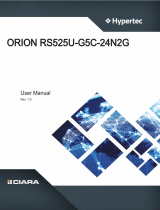
- 8 -
5-2-2 PSP Firmware Versions ..........................................................................................48
5-2-3 Legacy Video Select ...............................................................................................49
5-2-4 AST2500 Super IO Conguration ...........................................................................50
5-2-5 S5 RTC Wake Settings ...........................................................................................53
5-2-6 Serial Port Console Redirection .............................................................................54
5-2-7 CPU Conguration ..................................................................................................58
5-2-8 PCI Subsystem Settings .........................................................................................59
5-2-9 USB Conguration ..................................................................................................61
5-2-10 Network Stack Conguration ..................................................................................63
5-2-11 NVMe Conguration ...............................................................................................64
5-2-12 SATA Conguration.................................................................................................65
5-2-13 Graphic Output Conguration .................................................................................66
5-2-14 AMD Mem Conguration Status .............................................................................67
5-2-15 Tls Auth Conguration ............................................................................................68
5-2-16 ISCSI Conguration ................................................................................................69
5-2-17 QLogic 577xx/578xx 10 Gb Ethernet ......................................................................70
5-2-18 VLAN Conguration ................................................................................................77
5-2-19 MAC IPv4 Network Conguration ...........................................................................78
5-2-20 MAC IPv6 Network Conguration ...........................................................................79
5-3 AMD CBS Menu ............................................................................................. 80
5-3-1 CPU Common Options ...........................................................................................81
5-3-2 DF Common Options ..............................................................................................86
5-3-3 UMC Common Options ..........................................................................................91
5-3-4 NBIO Common Options ........................................................................................105
5-3-5 FCH Common Options ......................................................................................... 111
5-3-6 NTB Common Options .........................................................................................115
5-3-7 SOC Miscellaneous Control .................................................................................116
5-3-8 Workload Tuning ................................................................................................... 117
5-4 AMD PBS Menu ........................................................................................... 118
5-4-1 RAS ......................................................................................................................119
5-5 Chipset Setup Menu ..................................................................................... 121
5-5-1 North Bridge .........................................................................................................122
5-5-2 Fabric Resource ...................................................................................................123
5-6 Server Management Menu ........................................................................... 124
5-6-1 System Event Log ................................................................................................126
5-6-2 View FRU Information ..........................................................................................127
5-6-3 BMC Network Conguration .................................................................................128
5-6-4 IPv6 BMC Network Conguration .........................................................................129
5-7 Security Menu .............................................................................................. 130
5-7-1 Secure Boot .........................................................................................................131
5-8 Boot Menu .................................................................................................... 133























